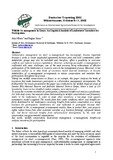| dc.description.abstract | Collaborative management (in short co-management) has increasingly become important
because it seeks to create negotiated agreements between state and local communities (other
stakeholder groups may also be included) and, therefore, offers a possibility to overcome
conflicts over natural resource exploitation. However, achieving successful co-management is
confronted with many challenges, one of the most pressing being achievement of effective
participation of the landowners or resource users in the management process. Moreover, it has
remained unclear as to what kinds of incentives would motivate landowners to become
stakeholders of co-management arrangements in nature conservation and maintain their
participation throughout the process.
Taking two wildlife conservancies in Kenya as an example, this paper analyses the kinds of
incentives that make landowners participate in collaborative management arrangements. The
fieldwork for the results presented in this paper was conducted in the wildlife dispersal areas of
Shimba Hills National Reserve and Amboseli National Park in Kenya, where a total of 136
households, based on two stratified random samples, were interviewed.
To assess the economic incentive for participation, a financial benefit-cost analysis is performed.
For both study areas, this analysis shows that investing in wildlife conservation is not financially
viable to the landowners. In order to study other incentives, a two-stage least squares
econometric model is applied. The results show that--under conditions where cash benefits are
fairly distributed to the landowners—receiving benefits from nature conservation is a strong
incentive for participation. Landowners are also motivated to participate because their
involvement in the co-management arrangements enables them to protect their own property
rights, reduce losses from other economic activities (e.g. livestock farming), safeguard human
life, and derive non-cash benefits from infrastructural developments by the state and
conservation non-governmental organisations. | en |

